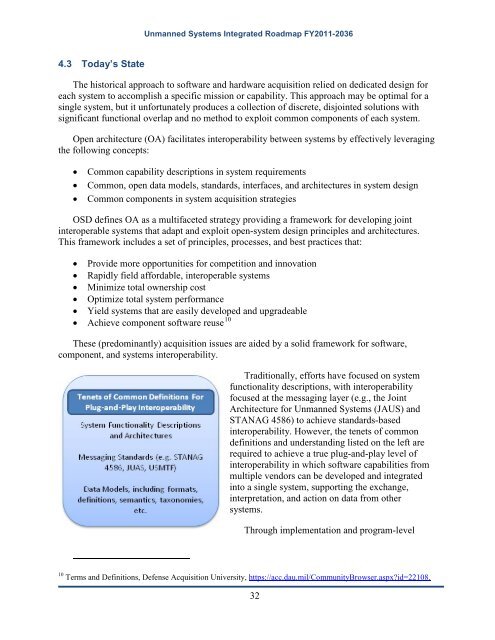Unmanned Systems Integrated Roadmap FY2011-2036 - Defense ...
Unmanned Systems Integrated Roadmap FY2011-2036 - Defense ...
Unmanned Systems Integrated Roadmap FY2011-2036 - Defense ...
Create successful ePaper yourself
Turn your PDF publications into a flip-book with our unique Google optimized e-Paper software.
4.3 Today’s State<br />
<strong>Unmanned</strong> <strong>Systems</strong> <strong>Integrated</strong> <strong>Roadmap</strong> <strong>FY2011</strong>-<strong>2036</strong><br />
The historical approach to software and hardware acquisition relied on dedicated design for<br />
each system to accomplish a specific mission or capability. This approach may be optimal for a<br />
single system, but it unfortunately produces a collection of discrete, disjointed solutions with<br />
significant functional overlap and no method to exploit common components of each system.<br />
Open architecture (OA) facilitates interoperability between systems by effectively leveraging<br />
the following concepts:<br />
• Common capability descriptions in system requirements<br />
• Common, open data models, standards, interfaces, and architectures in system design<br />
• Common components in system acquisition strategies<br />
OSD defines OA as a multifaceted strategy providing a framework for developing joint<br />
interoperable systems that adapt and exploit open-system design principles and architectures.<br />
This framework includes a set of principles, processes, and best practices that:<br />
• Provide more opportunities for competition and innovation<br />
• Rapidly field affordable, interoperable systems<br />
• Minimize total ownership cost<br />
• Optimize total system performance<br />
• Yield systems that are easily developed and upgradeable<br />
• Achieve component software reuse 10<br />
These (predominantly) acquisition issues are aided by a solid framework for software,<br />
component, and systems interoperability.<br />
Traditionally, efforts have focused on system<br />
functionality descriptions, with interoperability<br />
focused at the messaging layer (e.g., the Joint<br />
Architecture for <strong>Unmanned</strong> <strong>Systems</strong> (JAUS) and<br />
STANAG 4586) to achieve standards-based<br />
interoperability. However, the tenets of common<br />
definitions and understanding listed on the left are<br />
required to achieve a true plug-and-play level of<br />
interoperability in which software capabilities from<br />
multiple vendors can be developed and integrated<br />
into a single system, supporting the exchange,<br />
interpretation, and action on data from other<br />
systems.<br />
Through implementation and program-level<br />
10 Terms and Definitions, <strong>Defense</strong> Acquisition University, https://acc.dau.mil/CommunityBrowser.aspx?id=22108.<br />
32

















